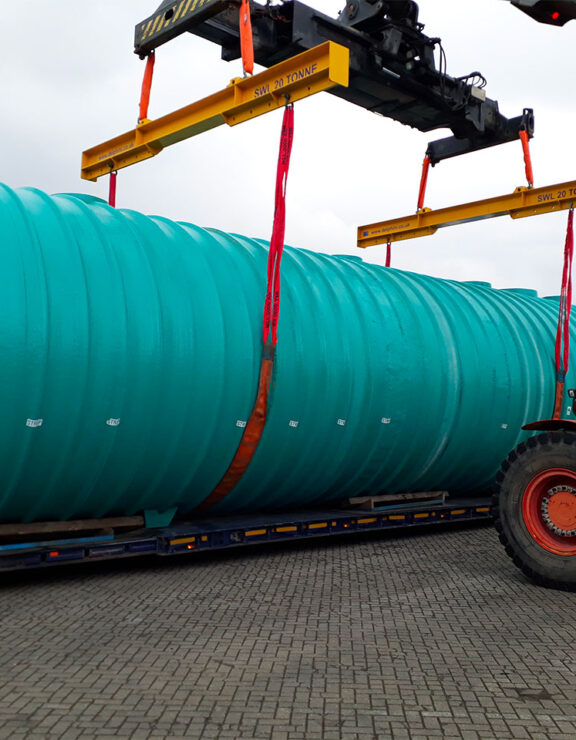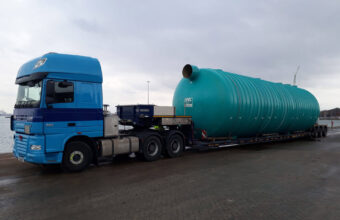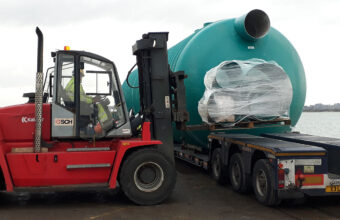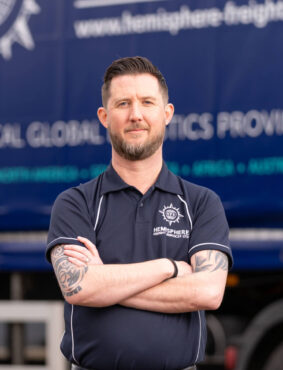
SPEL Products
Overview
It may only seem like yesterday that World Cup fever was in full swing, but preparations for the 2022 tournament in Qatar are already underway. Hemisphere has been getting involved by arranging the shipping of an underground tank manufactured by UK company SPEL Products which is destined for the Al Rayyan stadium.
Delivery
As we handle this commodity often, we had an idea of what to expect, but given every situation is different, we know not to take anything for granted. Before this project got off the ground, drawings were fully reviewed, and talks with the supplier, our agent and haulier ensued. Once we had the knowledge of the product and understood the expectations of the client and our suppliers, we set about finding the best shipping method for this particular tank.
Our logistical findings eventually determined a roll-on, roll-off (RORO) solution would be the most suitable, with delivery to port by an extended low loader trailer, where the tank would then be transferred by crane to a RORO trailer, allowing the combo to be pulled on to the vessel by a tug. Of course, Hemisphere’s project managers were to be deployed to oversee the transfer and also the loading to the vessel. With such a piece of equipment, it was key for us to be on hand to ensure our handling instructions were followed and that both the carrier and ourselves, on behalf of the client, were happy with everything.
Our thoughts
Working to Unique Specifications
Despite its size, the tank is relatively light at approximately 7500kg thanks to a Glass Reinforced Plastic construction. This has its advantages for transport and shipping, but it also dictates that any handling such as lifting and securing needs to be one with care and understanding.
Prior to transport and by paying attention to the haulier’s lashing plan, it was apparent that whilst the tank had ‘feet’ to prevent it rolling, a secondary measure was required to prevent unwanted movement and operate as a failsafe. The haulier had already constructed sleepers attached to angled blocks for similar tanks previously, so we commissioned further pieces to be built that could be transferred over once the tank had been positioned to the RORO trailer. With the tank successfully loaded to the low loader trailer along with the sleepers, the driver enjoyed a straight forward journey to Southampton port assisted by his escort.
On arrival, we were there to see the cargo roll into the port and carry out a condition check. Once complete, our attention turned to the lifting, and inspections to the planned lifting gear followed whilst we discussed the plan once again with the carrier’s ground crew.
It goes without saying a tank of this construction must be lifted using soft slings; these are positioned in set locations on the tank, pre-determined by the manufacturer and taking into account the tank’s centre of gravity and strength. It is also key that the straps are attached to spreader bars as wide as the tank itself to prevent the slings applying unwanted pressure. With everything in place, the lift and transfer were done without a hitch, and once the tank was placed on the RORO trailer, the timbers were put in place, checking the angle of the supports and not forcing them into the ribs to avoid point loading.
Results
With preparations continuing to prepare the cargo for boarding the vessel, we returned the following day to oversee the trailer being towed on board. In line with our 24/7 project management, although the vessel was not to sail until gone midnight and our cargo was to be one of the last pieces to load, Hemisphere was in attendance, this time alongside the manufacturer who happily joined us despite the unsociable hour!
This gave us the opportunity to review our lashing and securing plans with them directly and also watch the tank board the vessel together. This is something we never tire of, and as a manufacturer, seeing a completed product of this scale board a vessel to start the last leg of its journey must be pretty rewarding as well.






